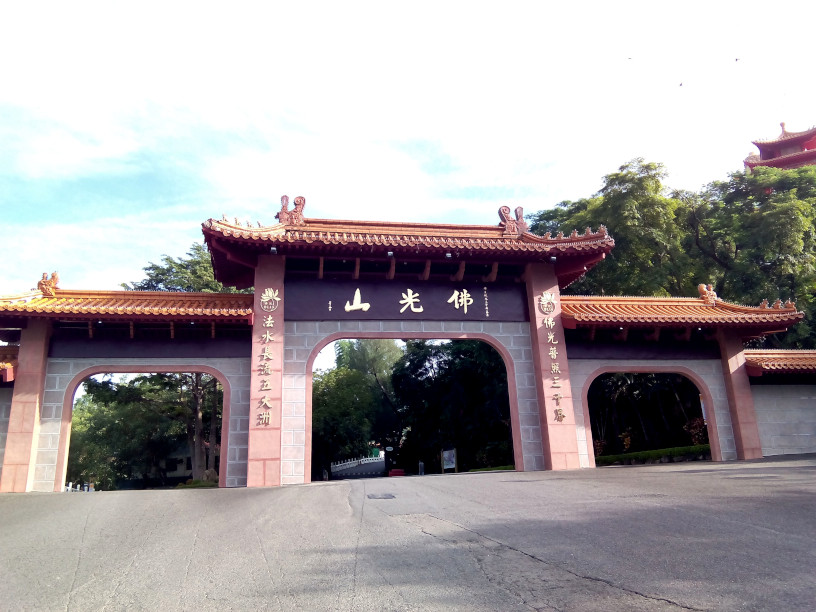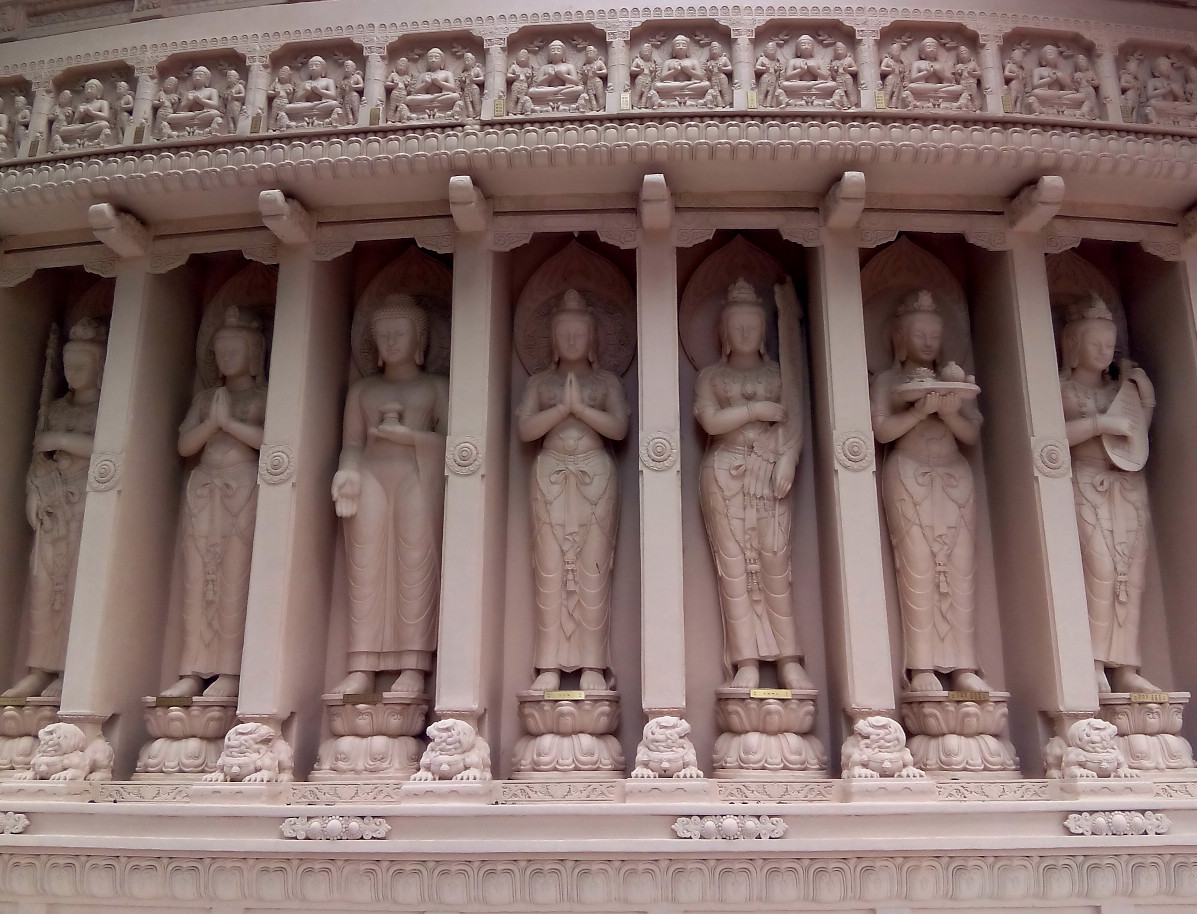In Remembrance of the Buddha: Nianfo and the Monastic Soundscape
Posted: 7th June 2021Contents
Introduction
I have recently been thinking about my experience in 2018 taking part in the 1-month “Buddhist Monastic Retreat” (FGBMR) program at Foguang shan 佛光山 (Gaoxiong 高雄, Taiwan)1. Situated within the monastery, the course involved academic lectures in Buddhist studies, workshops on monastic etiquette and ritual, and services (e.g. wanke 晚課). In addition to regular sūtra chanting (fanbai 梵唄), I also participated in a workshop in the use of Dharma instruments (faqi 法 器), specialising on the humble wooden fish 木魚. The program led to some tourism as well with, for example, a visit to the mountainous Foguang branch temple, Qingde si 清德寺 in Nantou 南投. Here in particular we were fortunate to hear a sublime presentation of the drum and bell driven Evening-bell gāthā (Muzhong ji 暮鐘偈)2. Generally speaking my experience at Foguang shan was rich in sound and listening. It is here where I started to think more closely about the study of sound and hearing in religious studies. Staying at the monastery, I was immersed in a rich sonic fabric, constantly oriented and informed about my surroundings via different audio queues.

One aspect in particular that grabbed my ears was the constantly playing nianfo 念佛 recording in the Buddha-name recitation hall (nianfo tang 念佛堂). Intended partly as an offering to Amitābha Buddha, it echoes the descriptions of musical offerings happening simultaneously in his western Pure Land (CBETA T.360.12:0273c14). In terms of nianfo, it is a practice crystallised in the six-character formula Namo Amituofo 南無阿彌陀佛, chanted repeatedly in a variety of styles. The intonation, meaning Homage to Amitābha Buddha, subsequently originates in practices relating to the recollection (buddhānusmṛti) of the qualities of a Buddha. Within Chinese Buddhism, nianfo is usually considered a soteriological practice3, pursued with intent on rebirth in the western Pure Land4 [1]. In this sense, having to pass by the hall daily on my laundry run, I was struck by the fact that it was usually empty. I was curious about what it means to hear an electro-acoustic reproduction of nianfo, especially considering the salvific function of hearing Amitābha’s name (CBETA T.366.12:0347b18)? Can a speaker replace the human chanter?
On Nianfo
Apart from musical offerings, non-musical sound is an integral component in both the descriptions of the western Pure Land, and its overall soteriological function. Among the accounts found in the three authoritative Pure Land sutrās5, music and sound arise spontaneously from the environment for the benefit of the hearer. This includes, for example, sounds ascribed to natural phenomena, in which harmonious breezes wafting through jewelled trees produce myriad wondrous sounds (CBETA T.360.12:0272a06). In Taishō 360, we also come across descriptions of its native Bodhi tree (Daochang shu 道場 樹), the site where a Buddhas awakening is achieved. The text describes how when subtle winds (weifeng 微風) gently waft through it, wondrous dharma-sounds (miaofa yin 妙法音) flow throughout other Buddha-lands (Foguo 佛國). When heard, one achieves deep insight into Buddhist truths (CBETA T.360.12:0271a02).
The offerings described above parallel the qualities of the western Pure Land, establishing a spiritually efficacious environment for the (passive) hearer. Wordly sounds, while a source of deluding sense-data (“dust;” guṇa, chen 塵), are re-calibrated to serve sentient beings, modelled after those in Amitābha’s realm [2]. Here, one is welcomed into a noise insulated and protected interior, and immersed in the recollection of Buddhist teachings, consolidated as the name of a Buddha. It is a form of ritual sound engineering (or soundscape design), that delimits spiritual time and space, and tunes the senses towards religious sensibilities [3]. Furthermore, as a type of acoustic architecture, it maintains the vision of a “this worldly pure land” (renjian jingtu 人間凈土), situated within a globalised Foguang shan eschatology [4]. In this regard, playing loud nianfo recordings among a route where 30-odd cosmopolitan men will regularly pass through is certainly fitting.

With the above in mind, the process of mirroring the sounds of the Pure Land echoes the idea of mutual resonance (ganying 感應) [5]. In this system, two categorically similar things resonate with each other, with the sound of our “this wordly” Pure Land tuning in with those of Amitābha’s. Or as purported in the early commentary of the Book of Changes (Yijing 易 經), ‘notes of the same key respond to one another’ (tong sheng xiang ying 同聲相應) [6]. Within the broader Mahayana notion of Buddhahood, sound is the vehicle by which Amitābha is able to respond to sentient beings in need. It is the skillful means (upāya; fangbian 方便) of the Buddhas to manifest the various spaces and places inline with our specific wants (e.g. CBETA T.475.14:0554a28). This is possible due to the infinite potential of the Buddha’s absolute nature, or dharmakāya (fashen 法 身), the crux of the three-way division of the Buddha’s body. Any responses to invocation are spontaneously carried out by the Buddha’s resonance-body (yingsheng 應身), a notion developed in China harmonising ganying with Indian Buddhist thought.
Hearing such a recording is, therefore, a way of tuning-in into this cosmic broadcast beacon, and the immanent reality it conversely seeks to create. These realities are further made possible by the intermediary and material nature of sound. Sound informs us of time, space and place, but it also has measurable physical qualities (frequency, timbre etc.). Hearing is, in a sense, a form of touching at a distance, with it’s tactile dimensions becoming notably evident at lower frequencies (~20 Hz), as vibration [7]. These substantial aspects of sound stimulate and sustain spatial metaphors, enclosing the hearer within a religious ambience. The process of attunement that follows moulds the hearer in accordance with the relevant religious ideals therein [8]. In this sense, simply hearing nianfo can have spiritual ramifications within the context of Pure Land practice and thought [9].
Conclusion
This post explored in brief the electro-acoustic reproduction of nianfo in contemporary Taiwanese Buddhism and Taiwanese Buddhist monasticism. This is especially in terms of the passive hearer, enveloped in a religious soundscape, in which processes of mutual resonance and attunement take place. Although this post is under-theorised, I believe these kinds of sensory approaches can provide complimentary insights in the study of contemporary East-Asian Buddhism. Future directions could potentially take into account other forms of sensory architecture, such as those created by smell and taste. It would be interesting to learn more about how, for example, incense offerings in the context of contemporary Pure Land Buddhism enhance religious space. This is particularly in regards to the ambition of Foguang shan to establish a this-worldy Pure Land, an attractive framework for the above efforts.
Footnotes
| [1] | The original advert can be viewed |
| [2] | I believe this is also generally referred to as the kouzhong ji 叩鐘偈, which also includes a rendition for the morning (Chenzhong ji 晨鐘偈). A poor quality version of the Foguang Muzhong ji (sans drums) can be listened to at YouTube via https://www.youtube.com/watch?v=xBfevsR5F8c. |
| [3] | This is of course a simplification. The act of invoking a Buddha’s name is also, for example, used as a meditation object in Chan (Zen) practice, akin to a huatou 話頭. In this context, a spatial understanding of a “Western Pure Land” is not necessarily important. |
| [4] | Known in Sanskrit as the Land of Bliss (S., sukhāvatī; sometimes rendered into Chinese as jile jingtu 極樂凈土). |
| [5] | Often referred to as the Longer (T.360.12), Shorter (T.366.12) and Contemplation sutrā (T.365.12) respectively. |
References
| [1] | C. B. Jones, Chinese Pure Land Buddhism: Understanding a Tradition of Practice. Honolulu: University of Hawai`i Press, 2019. |
| [2] | P.-y. Chen, “Sound and emptiness: Music, philosophy, and the monastic practice of buddhist doctrine,” History of Religions, vol. 41, no. 1, pp. 24--48, 2001. |
| [3] | C. Guillebaud, “Soundwalks in shiva temple: A situated approach to perceived ambiance,” in Worship Sound Spaces: Architecture, Acoustics and Anthropology (C. Guillebaud and C. Lavandier, eds.), pp. 104--121, Oxon: Routledge, 2020. |
| [4] | S. Chandler, Establishing a Pure Land on Earth: The Foguang Buddhist Perspective on Modernization and Globalization. Honolulu: University of Hawai'i Press, 2004. |
| [5] | R. H. Sharf, Coming to Terms with Chinese Buddhism: A Reading of the Treasure Store Treatise. Honolulu: University of Hawai'i Press, 2002. |
| [6] | “Yijing 易經 [western zhou 西周],” in Chinese Text Project (D. Sturgeon, ed.), 2022. [ https://ctext.org/ ] |
| [7] | R. M. Schafer, The Soundscape: Our Sonic Environment and the Tuning of the World. Rochester: Destiny Books, 1994. |
| [8] | C. Hirschkind, “Religion,” in Keywords in Sound (D. Novak and Sakakeeny, eds.), pp. 165--174, Durham: Duke University Press, 2015. |
| [9] | N. Heller, “Buddha in a box: The materiality of recitation in contemporary chinese buddhism,” Material Religion, vol. 10, no. 3, pp. 294--314, 2014. |